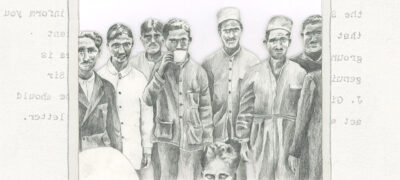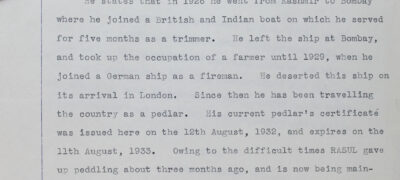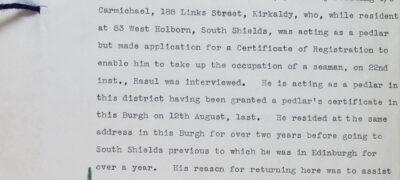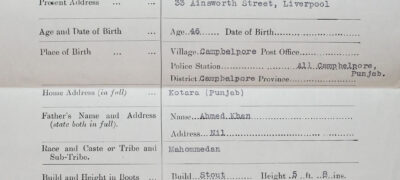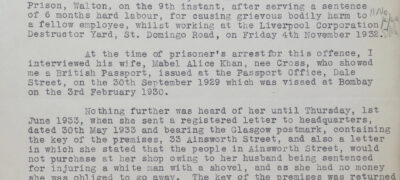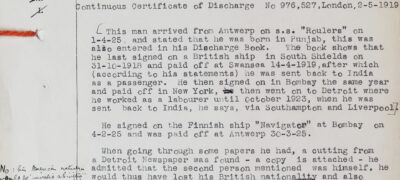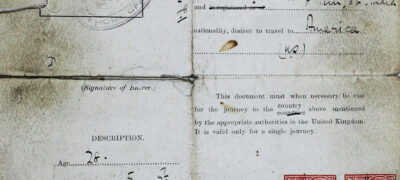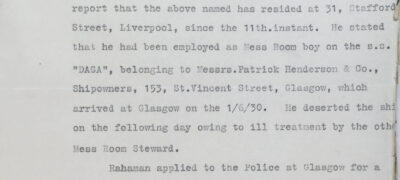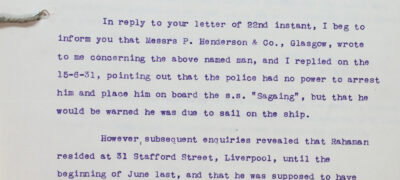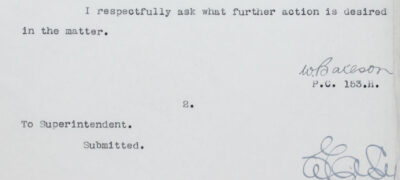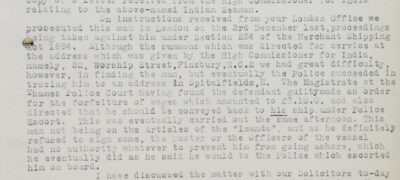
Download documents and transcripts
Teachers' notes
For a week in August 2021, a group of five young people connected online to take part in a project using archive documents to inspire a graphic novel. Documents at The National Archives tell the stories of seafarers from Mirpur, Bengal and the Panjab, who travelled to Britain working on board merchant ships in the 1920s-30s. In creative workshops led by acclaimed illustrator, Serena Katt, the young people learned how to script and illustrate a graphic story, conveying their interpretations of the seafarer’s lives.
The purpose of this resource is to use the graphic novel ‘Seafarers’ Stories’ to explore the experiences of Panjabi, Mirpuri and Bengali seafarers in Britain in the early 20th century.
We suggest that teachers start with the graphic novel resource. Begin by dividing the class into five groups (they can work in pairs or smaller groups).
Each group has one chapter of the graphic novel, each focusing on a different seafarer. There are five seafarers; Paku, Ghulam, Jan, Hassan and Latiffor.
Suggested questions for students:
- What is your story about?
- What can you learn about this seafarer’s life?
- What challenges did they face?
- What questions do you have at this point?
We advise that students then read through the context sheet (in the resource pack) in pairs/groups. There are discussion points at the bottom.
For the main activity each group analyses documents that relate to the same seafarer they looked at before.
- They should start with Document (a) and discuss the questions with their group. Then do the same with the Follow up document. There is a glossary to support students. In addition a teacher might want to print the typed transcript for students to meet their learning needs.
- Get students to feedback to the class on what their documents have revealed.
Suggested questions for the class:
- What did the documents reveal about your seafarer’s life?
- What surprised/ shocked you from learning about these seafarers?
We have some suggested follow up activities for students:
- Illustrate their own chapter design for their seafarer.
- Write a new short scene that adds to their seafarer’s story inspired by the documents.
Download the graphic novel here
Download printable resource pack with images and transcripts
Background
India had a long tradition of seafaring which stretched back to the 18th century. Numbers of Indian sailors (known as lascars) rose in the 19th century because of free trade and expansion of the British shipping industry. Steam-powered ships created new types of jobs in the engine rooms, but the jobs were very tough.
Being born in British-ruled India, the lascars were considered British, but shipping companies employed them on contracts known as Asiatic or Lascar Articles. They were paid only one fifth to one quarter of a British sailor’s wage and had much inferior living conditions whilst onboard. The lascars inhabited a world deeply marked by racial discrimination.
According to the Lascar Articles, the lascars could only be discharged (allowed to leave ship) and be paid their wages in India. Indian seamen sometimes jumped ship, hoping to obtain better pay and conditions under British Articles (contracts). Or they would desert their ship when it had docked in order to try and get a job on land. They often became pedlars (travelling salespeople), as this was a job that required very few resources.
In Britain, Indian seafarers were experiencing racial discrimination in the context of the Special Restriction (Coloured Alien Seaman’s) Order 1925. This legislation required seamen from the empire to carry documentary proof of their status as British. This was often extremely difficult to obtain, and as a result, some seafarers (who were British subjects) were wrongly labelled as ‘aliens’.
Connections to Curriculum
Key Stage 3
Relevant to ideas, political power, industry and empire: Britain, 1745-1901
Challenges for Britain, Europe and the wider world 1901 to the present day
Key Stage 4
OCR GCSE
Migrants to Britain, c.1250 to present
AQA
Migration, empires and the people: c790 to the present day
Edexcel
Migrants in Britain, c800- present
Tasks
1. Look at the graphic novel Seafarers’ Stories.
2. Documents about seafarer Ghulam Rasul (HO 45/15774).
Document (a):
- Who made this document?
- What do you learn about your seafarer’s journey?
- Look at the section with ‘subject’. What is unusual here? Why do you think is it written like this?
- Why has Ghulam been interviewed? What does he want?
- What does this document reveal about your seafarer’s life?
Document (b):
- Who made this document?
- This document was made a few months after the first. Where is Ghulam now living? Why did he move here?
- What more do we learn about Ghulam’s life?
3. Documents about seafarer Hassan Khan (HO 45/15863).
Document (a):
- What type of document is this?
- Who made this document?
- How many locations can you find?
- What does this document tell you about your seafarer’s life?
Document (b):
- What type of document is this? Who made it?
- What has happened to Hassan?
- What has been the impact of this?
- What does this document tell you about your seafarer’s life?
4. Documents about seafarer Jan Mohamed (HO 45/13750).
Document (a):
- What type of document is this?
- What do we learn about your seafarer’s journey?
- The author uses language like ‘states’ and gives two different version of Jan’s name.
- What does this reveal about the attitudes of the authorities?
- Why was this document made?
Document (b):
- What type of document is this?
- Look closely at the stamp. Who produced this document?
- Why was this document produced?
- What more does this document reveal about Jan?
5. Documents about seafarer Latiffor Rahaman (HO 45/14443).
Document (a):
- What type of document is this?
- Who has made it?
- What was Latiffor doing as a job when he left the ship?
- How do you think he would have felt leaving?
- What does this document tell you about your seafarer’s life?
Document (b):
- What type of document is this?
- Does this document tell you more about how Latiffor made a living?
- What does this document tell you about your seafarer’s life?
6. Documents about seafarer Paku Miah (HO 45/14874).
Document (a):
- Who produced this document? (Look at the signatures for a clue)
- Who was it sent to?
- What do we learn about Paku?
- Why was this document made?
Document (b):
- What type of document is this?
- Read the first part of the main paragraph.
- What did the court decide would happen to Paku?
- Read the second part of the main paragraph.
- What happened when the police took Paku back to the ship?
- What does this document reveal about your seafarer’s life?
